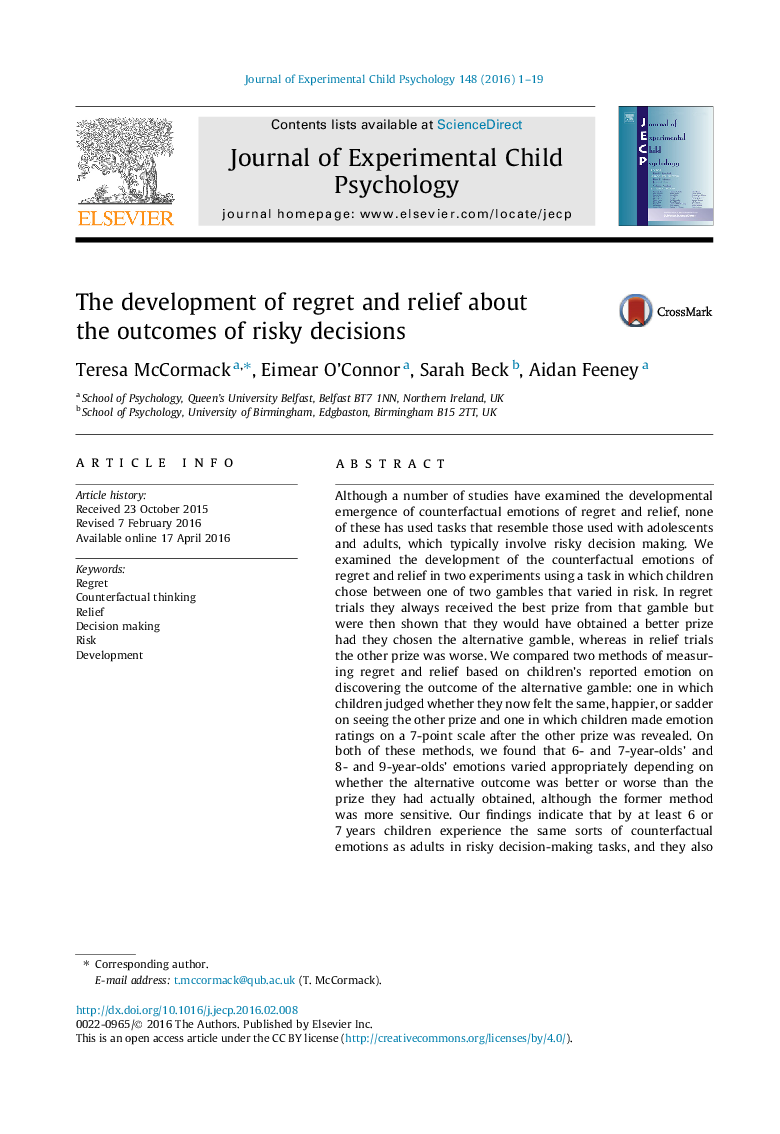| کد مقاله | کد نشریه | سال انتشار | مقاله انگلیسی | نسخه تمام متن |
|---|---|---|---|---|
| 7274644 | 1473464 | 2016 | 19 صفحه PDF | دانلود رایگان |
عنوان انگلیسی مقاله ISI
The development of regret and relief about the outcomes of risky decisions
ترجمه فارسی عنوان
توسعه تاسف و تسکین در مورد نتایج تصمیمات خطرناک
دانلود مقاله + سفارش ترجمه
دانلود مقاله ISI انگلیسی
رایگان برای ایرانیان
کلمات کلیدی
پشیمان بودن، تفکر فاقد فاکتور، تسکین، تصمیم سازی، خطر، توسعه،
ترجمه چکیده
اگر چه تعدادی از مطالعات به بررسی ظهور رشد عواطف ضد افسانه از تاسف و تسکین پرداختند، هیچ یک از آنها از وظایفی استفاده نمیکردند که شبیه استفاده از نوجوانان و بزرگسالان است که معمولا شامل تصمیم گیری مخاطره آمیز است. در دو آزمایش، با استفاده از یک وظیفه ای که در آن کودکان بین یکی از دو قمار که در معرض خطر هستند، توسعه ی احساسات تقلیدی از تاسف و تسکین را مورد بررسی قرار دادیم. در محاکمات پشیمانی، آنها همیشه بهترین جایزه را از این قمار دریافت کردند، اما بعدا نشان داده شد که اگر جوایز جایگزین را انتخاب کرده بودند، جایزه بهتر را بدست آورند، در حالی که در دادگاه های امداد جایزه دیگری بدتر بود. ما دو روش سنجش تاسف و تسکین را براساس احساسات گزارش شده کودکان درباره کشف نتیجه قمار جایگزین مقایسه کردیم: یکی که در آن کودکان تصور می کردند که آیا آنها در حال حاضر احساس یکسان بودن، شادتر یا غم انگیز بودن در دیدن جایزه های دیگر و یکی که در آن کودکان ساخته شده است رتبه های احساسی در مقیاس 7 نمره پس از جایزه دیگر نشان داده شد. در هر دو روش، ما دریافتیم که احساسات 6- و 7 ساله و 8- و 9 ساله به طور مناسب بسته به اینکه آیا نتیجه جایگزین بهتر یا بدتر از جایزه است که در واقع به دست آمده، متفاوت است، هر چند روش اول حساس تر بود. یافته های ما نشان می دهد که با حداقل 6 یا 7 سالگی کودکان، کودکان همانند احساسات ضد عاطفی مانند بزرگسالان در انجام وظایف تصمیم گیری خطرناک، تجربه می کنند، و همچنین نشان می دهد که این احساسات با توجه به اینکه کودکان می توانند تصمیم گیری های احساسی تطبیقی را انجام دهند، بهترین راه اندازه گیری است.
موضوعات مرتبط
علوم انسانی و اجتماعی
روانشناسی
روانشناسی رشد و آموزشی
چکیده انگلیسی
Although a number of studies have examined the developmental emergence of counterfactual emotions of regret and relief, none of these has used tasks that resemble those used with adolescents and adults, which typically involve risky decision making. We examined the development of the counterfactual emotions of regret and relief in two experiments using a task in which children chose between one of two gambles that varied in risk. In regret trials they always received the best prize from that gamble but were then shown that they would have obtained a better prize had they chosen the alternative gamble, whereas in relief trials the other prize was worse. We compared two methods of measuring regret and relief based on children's reported emotion on discovering the outcome of the alternative gamble: one in which children judged whether they now felt the same, happier, or sadder on seeing the other prize and one in which children made emotion ratings on a 7-point scale after the other prize was revealed. On both of these methods, we found that 6- and 7-year-olds' and 8- and 9-year-olds' emotions varied appropriately depending on whether the alternative outcome was better or worse than the prize they had actually obtained, although the former method was more sensitive. Our findings indicate that by at least 6 or 7Â years children experience the same sorts of counterfactual emotions as adults in risky decision-making tasks, and they also suggest that such emotions are best measured by asking children to make comparative emotion judgments.
ناشر
Database: Elsevier - ScienceDirect (ساینس دایرکت)
Journal: Journal of Experimental Child Psychology - Volume 148, August 2016, Pages 1-19
Journal: Journal of Experimental Child Psychology - Volume 148, August 2016, Pages 1-19
نویسندگان
Teresa McCormack, Eimear O'Connor, Sarah Beck, Aidan Feeney,
